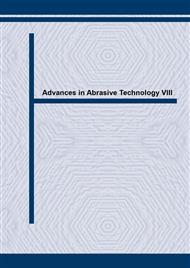p.443
p.447
p.453
p.459
p.465
p.471
p.475
p.483
p.489
Prevention from Delamination of Composite Material during Drilling Using Ultrasonic Vibration
Abstract:
Composite materials are used for many structures because of its high strong-to-weight ratio and easy formation. Secondary machining processes such as drilling and sawing are required to assemble and join composite materials to other structures. When composite materials are machined, delamination occurs at adhesive layer between laminated layers. It is well known that it is possible to cut hard metals and to improve precision of machined surface by using ultrasonic vibration. This method is applied to machining composite materials in this paper. Drilling of composite materials is focused on. First, this method is examined experimentally. Next, experimental results are examined by analytical method. Using condition of experiment, prevention of delamination can be demonstrated from the proposed analytical method.
Info:
Periodical:
Pages:
465-470
Citation:
Online since:
August 2005
Authors:
Price:
Сopyright:
© 2005 Trans Tech Publications Ltd. All Rights Reserved
Share:
Citation:


